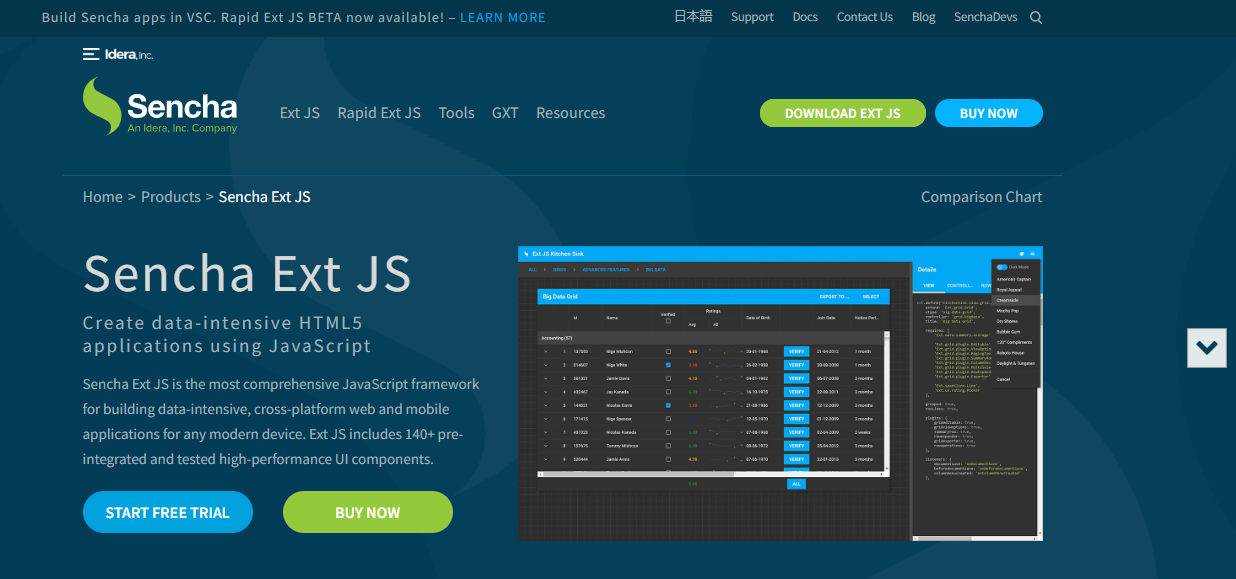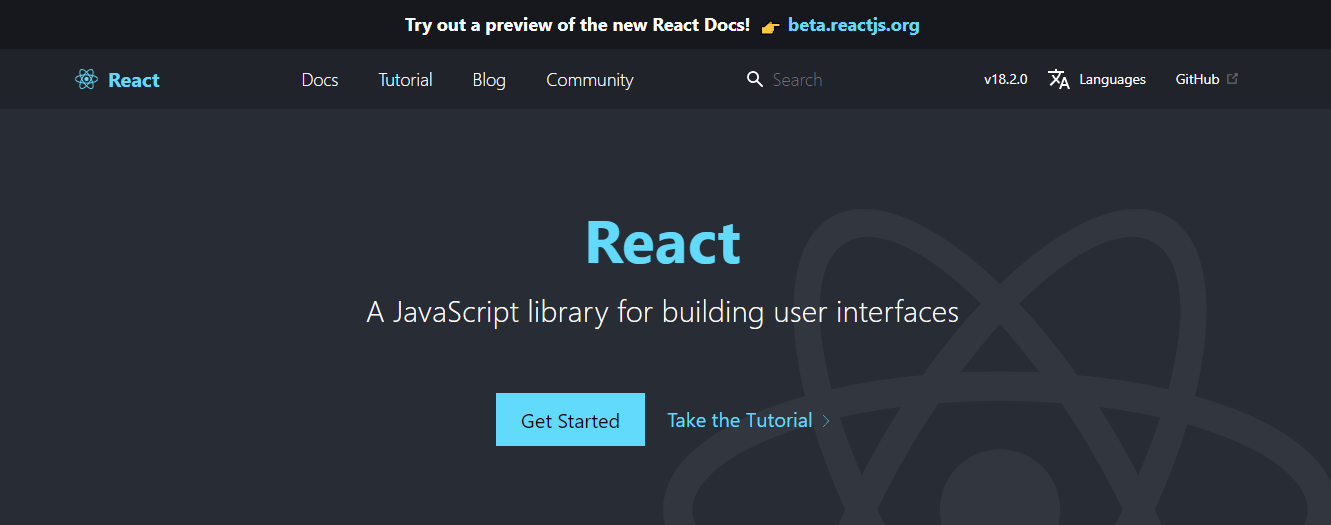A Comprehensive Guide to JS Frameworks: Ext JS vs. React vs. Angular
Are you a web developer or a business owner looking to choose the right JS frameworks for building interactive applications? Then, you must read our comprehensive guide till the end. The decision-making process is a little difficult because of the multiple options available in the market. If you choose the right tool mistakenly, it can result in frustration. That’s where our comprehensive guide comes in to help you make the right choice. This guide will focus on the three most popular JavaScript frameworks: React, Angular, and Ext JS.
Moreover, we will explore these frameworks’ strengths and weaknesses. It will help you analyse your business needs and choose the right framework. When comparing Sencha vs React components, Ext JS offers a more comprehensive and enterprise-ready set of UI components for data-intensive applications. Let’s keep reading till the end to choose between React, Ext JS, and Angular.

What Are JS Frameworks?
Developers should know JS frameworks are the pre-collected tools, libraries, and functions. It helps us build our application quickly. In other words, you don’t need to build everything from scratch. Moreover, we get an organized and structured foundation to build interactive and dynamic applications. Some of the most common benefits that these frameworks offer are given below:
- Uniform structure in the code base
- Scalability to adapt to the growing needs of the business
- Optimized for speed and efficiency
- High performance
- Community support

What Are Some of the Most Popular JS Frameworks?
Many popular JavaScript frameworks are available in the market for building web applications. As mentioned earlier, we will just focus on three major ones. Let’s explore.
Sencha Ext JS
Sencha Ext JS is one of the best JavaScript frameworks. It is a feature-rich framework built for cross-platform and data-intensive web apps. Moreover, Ext JS has powerful data management capabilities such as data binding. At the same time, it has a beautiful set of UI components. Here is what we get from Ext JS:
- Pre-written UI components such as grids, charts, trees, and forms.
- Data handling through stores and models.
- Data retrieval using a proxy support
- Model View Controller architecture
- Responsive design
- Excellent support and documentation
It is important to note that we can use Ext JS for the following purposes:
- Enterprise applications
- Admin dashboards
- Custom web applications
- Complex forms and data entry
Advantages of Using Ext JS
Ext JS comes with multiple benefits. Some of them are written as under:
- It has a rich set of UI components. The best part about those components is their customizability and diversity. Hence, saving a lot of time.
- Ext JS excels in creating applications that are data-driven. We get access to models, proxy support, and stores for data manipulation and retrieval.
- Ext JS comes with detailed documentation and community support. This makes it easier for developers to implement Ext JS.
- Ext JS gives us cross-browser compatibility.
- The MVC structure helps us with a clean code structure.

React
React free JavaScript framework is a popular and open-source JavaScript library that is developed and maintained by Facebook. It can help us build user interfaces in web applications. It is interesting to know that the key concept in React is about virtual DOM. DOM refers to the document object model. It helps us update the user interface efficiently without updating the DOM in the actual browser directly.
React comes with a declarative and component-based approach. This is what makes it highly maintainable and reusable. Here are some advantages of using React:
Virtual DOM results in improved performance
- High reusability
- Declarative syntax
- One-way data binding
- Strong community.
Some disadvantages of using React are:
- The steep learning curve for beginners
- Boilerplate code
- Integration challenges for complex applications

Building a Simple React Application:
import React from 'react';
class App extends React.Component {
render() {
return <div>Hello, React!</div>;
}
}
export default App;
Angular
Angular is another open-source JavaScript framework developed by Google. If you are looking to build single-page applications then Angular can be one of your options. This framework is popular for its comprehensive set of features to build web components. Hence it is a robust choice for building interactive web apps. Here is what we get from Angular:
- Component-based architecture
- Comes with directives such as ngIf, ngFor, and ngStyle.
- Modular and testable code due to dependency injection.
- Routing
- Two-way data binding
- HTTP client
- Reactive forms
Here are some pros of using Angular:
- Cross-platform web development
- Strong community and support
- Structured and maintainable code
- TypeScript
Here are some cons of using Angular:
- Complex learning curve
- Boilerplate code
- Integration challenges
- Large-size applications may impact the load times.

What Is the Comparison Between Ext JS, React, and Angular?
After analysing the features, pros, and cons of the three most popular frameworks, it is time to compare them. According to our observation and research, we have curated the following results:
- Ext JS is ideal for building enterprise applications such as CRMs, financial software, and dashboards. However, the additional features and complexity may lead to unnecessary overhead in simple applications. The unique component model and extensive features can result in a steep learning curve. Virtimo is using Ext JS for its web applications.
- React JS is highly suitable for single-page applications and general user interfaces. We can choose it for applications or projects that require flexibility. Moreover, we can also use it for projects that require integration with other libraries and frameworks. It comes with a good performance, but the inefficient component design can lead to low performance. Facebook, Airbnb, and Netflix are using React.
- Angular is a more suitable framework for full-fledged web pages with a complex and rich set of features. Moreover, it catches errors during compile time due to the availability of TypeScript. The best part about this framework is the strong support from Google. Google, IBM, and PayPal are using Angular.
Whitepaper of Ext JS vs. React VS. Angular

Conclusion
From our comprehensive guide, you must have realized many factors to choose the right framework. Remember, choosing the wrong framework can lead to frustration and a waste of time and resources. Therefore, it is always important to know the requirements of your project before investing your time and money in any tool.
We have explored Ext JS, React JS, and Angular. At the same time, we have discussed their features, pros, and cons. Now, you have complete guidance to get the best framework and enhance the app development process.
Frequently Asked Questions
Why Are Javascript Frameworks Important in Web Development?
JavaScript frameworks enhance the efficiency of web development by saving time, allocating pre-built components, and strong community support.
Why Choose Sencha Ext JS Over React and Angular?
Ext JS is more suitable for data-intensive enterprise applications as compared to React and Angular.
Where Can I Learn More About These Frameworks?
You can learn about these frameworks through their documentation. Moreover, you can also check YouTube channels and Facebook groups where developers guide about these frameworks.
How Many Frameworks Does JavaScript Have?
There are so many frameworks available in the market. However, Ext JS, React, and Angular are the most popular ones.
Sign Up for free at Sencha Ext JS and build data-driven web applications for your enterprise.

Every software project begins with a choice that reverberates through its entire lifecycle: which development…

Building software for regulated industries demands more than functional code. Healthcare organizations must protect patient…

The Ext JS Data Grid is widely regarded as one of the most feature‑rich and…










